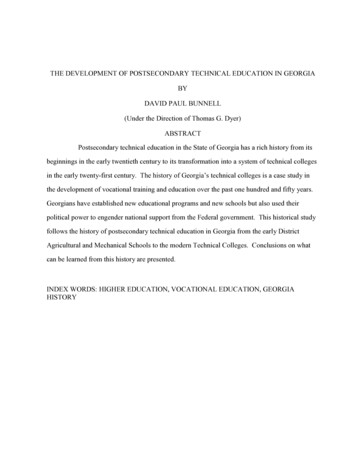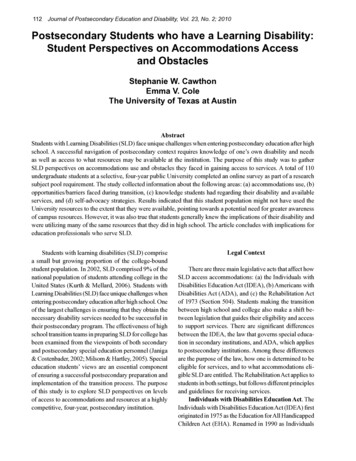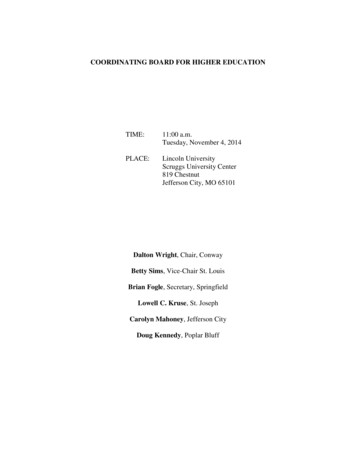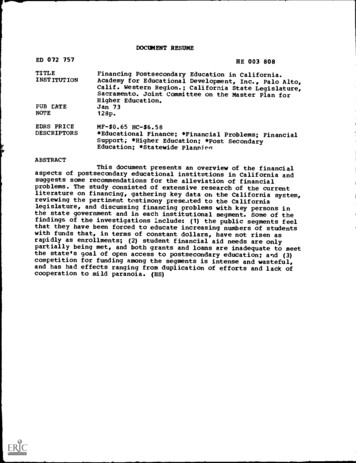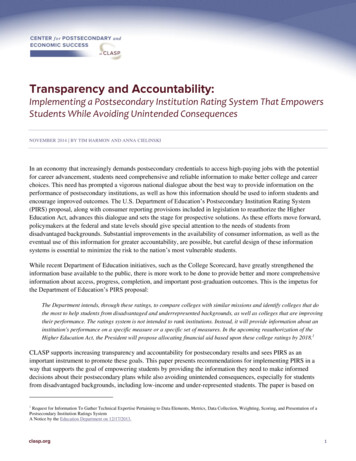
Transcription
Implementing a Postsecondary Institution Rating System That EmpowersStudents While Avoiding Unintended ConsequencesNOVEMBER 2014 BY TIM HARMON AND ANNA CIELINSKIIn an economy that increasingly demands postsecondary credentials to access high-paying jobs with the potentialfor career advancement, students need comprehensive and reliable information to make better college and careerchoices. This need has prompted a vigorous national dialogue about the best way to provide information on theperformance of postsecondary institutions, as well as how this information should be used to inform students andencourage improved outcomes. The U.S. Department of Education’s Postsecondary Institution Rating System(PIRS) proposal, along with consumer reporting provisions included in legislation to reauthorize the HigherEducation Act, advances this dialogue and sets the stage for prospective solutions. As these efforts move forward,policymakers at the federal and state levels should give special attention to the needs of students fromdisadvantaged backgrounds. Substantial improvements in the availability of consumer information, as well as theeventual use of this information for greater accountability, are possible, but careful design of these informationsystems is essential to minimize the risk to the nation’s most vulnerable students.While recent Department of Education initiatives, such as the College Scorecard, have greatly strengthened theinformation base available to the public, there is more work to be done to provide better and more comprehensiveinformation about access, progress, completion, and important post-graduation outcomes. This is the impetus forthe Department of Education’s PIRS proposal:The Department intends, through these ratings, to compare colleges with similar missions and identify colleges that dothe most to help students from disadvantaged and underrepresented backgrounds, as well as colleges that are improvingtheir performance. The ratings system is not intended to rank institutions. Instead, it will provide information about aninstitution's performance on a specific measure or a specific set of measures. In the upcoming reauthorization of theHigher Education Act, the President will propose allocating financial aid based upon these college ratings by 2018.1CLASP supports increasing transparency and accountability for postsecondary results and sees PIRS as animportant instrument to promote these goals. This paper presents recommendations for implementing PIRS in away that supports the goal of empowering students by providing the information they need to make informeddecisions about their postsecondary plans while also avoiding unintended consequences, especially for studentsfrom disadvantaged backgrounds, including low-income and under-represented students. The paper is based on1Request for Information To Gather Technical Expertise Pertaining to Data Elements, Metrics, Data Collection, Weighting, Scoring, and Presentation of aPostsecondary Institution Ratings SystemA Notice by the Education Department on 12/17/2013.1
CLASP’s PIRS comments to the Department of Education, as well as our testimony to the Advisory Committee onStudent Financial Assistance on PIRS. CLASP has also authored a companion briefing paper, Workforce ResultsMatter: The Critical Role of Employment Outcome Data in Improving Transparency of Postsecondary Educationand Training, focusing on the importance of including employment-related outcomes, such as post-graduationemployment rates and earnings levels.Our recommendations for PIRS recognize the sharp distinction between the goal of increasing transparency ofinformation about postsecondary education and the goal of holding institutions or programs accountable foroutcomes. Transparency in this context refers to the ability of postsecondary education consumers to access thefacts they need to make an informed decision about whether to enroll in postsecondary education, what to study,where to enroll, and how to finance their education. Accountability can take many forms, including the creation andimposition of minimal standards of performance that are meant to remove unqualified providers. It can also involvefinancial or other incentives to spur performance improvements or corrective actions intended to help institutionsmeet minimal standards. Accountability is concerned not only with what the results are for an institution but alsowhat they should be (i.e., what is reasonable and fair to expect).Any foreseeable use of PIRS may have unintended consequences that should be minimized in the ways this papersuggests. Using PIRS to support institutional accountability, in particular, creates special concerns about thepotential for unintended consequences. The stakes would be very high; PIRS could affect an institution’s Title IVeligibility or the amount of Title IV funds available to an institution. Using PIRS for institutional accountabilitywould be much more likely to lead to undesired responses than would other uses. It is reasonable to imagine that,confronted with the prospect of losing funds, institutions might reduce their focus on Pell grant recipients and otherlower-income students or otherwise change their enrollment process in a way that reduces opportunities for lowerincome students.In our view, it is possible to implement PIRS in a way that greatly reduces the potential for these types of negativeresponses. The potential pitfalls are real; however, the solution is not to forego establishing PIRS but rather todevelop and use PIRS the right way. This paper outlines several recommendations that are intended to accomplishthis. Whatever form PIRS ultimately takes, we recommend that its design and uses be carefully assessed to estimatethe potential impact on students from disadvantaged backgrounds, including low-income and under-representedstudents. For more on this, see Reforming Student Aid: How to Simplify Tax Aid and Use Performance Metrics toImprove College Choices and Completion.Existing data sources may be adequate to provide consumer information. However, these data sources are in needof substantial improvement.2 For this reason, we do not support the use of PIRS for accountability purposes untilseveral critical data shortcomings are addressed, including additional data collection and improved connections2Mapping the Postsecondary Data Domain: Problems and Possibilities, Technical Report. Mamie Voight, Alegnetta A. Long, Mark Huelsman, and JenniferEngle. March 2014, Institute for Higher Education Policy, Washington, DC.2Implementing a Postsecondary Institution Rating System That Empowers Students While Avoiding Unintended Consequences
between federal databases that are needed to calculate several of the proposed metrics. Key data needs include: Increased coverage of students: Completion rates are difficult to estimate because of limited data coverageof students in community colleges and other institutions that serve students who are not attending schoolfor the first time. This is beginning to change with the collection of additional information on non-first timeand part-time students through the Integrated Postsecondary Education Data System (IPEDS). Theexpected changes to IPEDS will increase the coverage of non-first-time and part-time students and shouldeventually allow for calculation of an expanded graduation rate. More information on student characteristics to support calculation and disaggregation of outcomes forsub-groups of students: Student outcomes available through IPEDS cannot be disaggregated by enrollmentstatus, age, socioeconomic status, or other student characteristics that can provide a complete picture ofpostsecondary results. For example, the revised version of the IPEDS outcome measures are expected to bereported in the aggregate for all students in an enrollment category. Ultimately, student-level data may needto be made available to ensure access and outcome data include the disaggregation needed for transparencyand accountability. Additional data on student progress, especially in less selective institutions: The measures of enrollment inremedial instruction and enrollment in college-level instruction cannot be calculated without new datacollection. These measures, as outlined below in recommendation 2, are needed to assess the extent towhich colleges are helping students progress toward graduation. Here, as above, access to student-leveldata may be necessary to efficiently gather this information. Access to reliable information on post-program earnings. Although earnings measures can be calculatednow for a limited set of students in the National Student Loan System Database (NSLDS), substantialimprovements are needed to make broader use of this data. Access to national or cross-state employmentdata is needed to provide information about labor market outcomes, such as median earnings. 3 In addition,these data must be connected to information about the student’s program of study, so that earnings resultscan be produced by program. Otherwise, earnings comparisons between institutions will simply reflect theirvaried program offerings.CLASP recommends including a range of measures that reflect the goals of student access, student progress,completion, and post-graduation outcomes (Table 1). The advantage of a range of measures is that it better reflectsthe array of key goals for postsecondary institutions, including student access and progress, as well as completionand post-graduation outcomes. This will help reduce the focus on a single objective, such as graduation rate, at theexpense of other goals.3Workforce Results Matter: The Critical Role of Employment Outcome Data in Improving Transparency of Postsecondary Education and Training. TimHarmon, Neil Ridley, with Rachel Zinn, Workforce Data Quality Campaign, April 2014, CLASP, Washington, DC.3Implementing a Postsecondary Institution Rating System That Empowers Students While Avoiding Unintended Consequences
Access and affordability: College access andcollege costs. Does this institution provide accessto low-income students? Is it affordable forstudents from a range of backgrounds?Percent of students receiving Pell or other need-based financialaidNet pricePercent of students retained in subsequent yearStudent Progress: Progress of students towardcompletion. Are students at this institutionshowing progress toward completing theireducation by reaching key milestones?Percent of students enrolled in and completing developmentaleducation or remedial courseworkPercent of students completing college-level “gateway” coursesCredit accumulation in a postsecondary program of studyCertificate/credential attainment rateCompletion: Student completion and attainmentof credentials. How many students attain acredential or degree from this institution? Howmany transfer to another college?Degree attainment rateTransfer rateEmployment ratePost-graduation results: Employment, earnings,and debt burden after graduation. What levels ofearnings do students have following graduation?Are students able to repay their loans? Are theyburdened with high debt?Median earnings one to two years following graduationMedian earnings five years following graduationAverage debt of students with college loan debtLoan repayment ratesConsistent with the recommendation to include a range of metrics, CLASP also recommends that the results ofthese metrics not be reduced to a single composite rating or score. Because there are so many factors that contributeto institutions’ composite ratings, their value to consumers is very limited. Not all metrics are of equal importanceto consumers. Some may, for example, place a higher priority on net price and a lower priority on graduation rate.4Implementing a Postsecondary Institution Rating System That Empowers Students While Avoiding Unintended Consequences
Composite ratings could be especially problematic if PIRS is used in the future for accountability purposes; theymay be difficult to understand and difficult to use for program or institutional improvement. Treating institutionsfairly would seem to require that any disqualification thresholds be based on clear criteria. These criteria should bedesigned to remove those institutions that fail to meet minimal standards of performance over time. Settingthresholds based on a single criterion can create strong incentives to game results or distort institutional missionsand may also have other undesired results. No institution should ever be confused about the minimal threshold orthe metric(s) they must improve to protect Title IV eligibility.CLASP strongly supports using PIRS to promote consumer awareness and choice. Increased transparency can makethe postsecondary education and training market more functional. Armed with better data, consumers will havemore options and increased chances of making informed choices about college and career goals. Additionally,enrolled students may use information about results at their institution to advocate for institutional improvement.Among employers, policymakers, and other stakeholders, consumer information may be used to identifyachievement gaps and begin to address them. In order to realize this vision in a way that minimizes unintendedconsequences, PIRS should be integrated into college access programs and career guidance, as well as empowerstudents to use data effectively.Presentation of PIRS results: It is important that metrics results be available, easy to use, and presented tostudents in an appropriate context to support effective decision making. In general, data for each of the metricsreported in PIRS should be presented in four ways: Overall results for each metric (How did this college perform on each metric?);Results for subcategories of interest to the consumer, such as programs of study or types of students (Howdid this college perform for students like me?);Comparison of results to the average for institutions in the peer group (How does this college compare toother similar colleges?); andComparison of results to those of the other institutions selected by the consumer (How does this collegecompare to other colleges I have selected?)Disaggregation of PIRS results: In order to enable consumers to use PIRS data successfully, information onresults—not just access—must be presented for sub-groups of students for comparison purposes. This is true fortwo reasons. First, for consumer information purposes, students need to be able to see how each institutionperforms—not just for all students but for students like themselves. A prospective low-income student should beable to see institutional results for Pell grant recipients, because these can reveal important differences betweeninstitutions that would not otherwise be apparent (Table 2).For example, if results are not presented for sub-groups for comparison purposes, a Pell-eligible prospective studentmay select College D in Table 2 because of its high overall graduation rate. If that student had access to graduationrates for Pell students in particular, he or she might have chosen College C, which has the highest Pell studentgraduation rate.5Implementing a Postsecondary Institution Rating System That Empowers Students While Avoiding Unintended Consequences
College A45%50%43%47%College B50%35%41%55%College C70%25%60%73%College D75%15%50%79%Second, in order for PIRS to be used for accountability purposes, it must show results for categories of studentsfrom disadvantaged backgrounds. Disaggregating outcomes may help reduce negative consequences for thesestudents in the face of increased performance pressure. If results are presented for sub-groups of students togetherwith information about access, it becomes possible to measure and begin to address critical achievement gaps ordisparities in educational and labor market outcomes. Also, these data can be used to “level the playing field”between schools that have similar missions but serve very different student populations.Student results should be disaggregated and presented for the following sub-groups: Programs of study: This would be helpful for each of the metrics but is of particular importance foremployment and earnings results, which are most useful when presented in the context of a program ofstudy.Pell Grant recipients: Does the institution obtain good results for both Pell recipients and non-Pellrecipients?Full-time/part-time/mixed enrollment status: Students’ ability to attend full time heavily affects theirprospects for graduation. It’s a disservice to students not to make this reality clear. Further, students shouldbe aware that some schools are more successful than others with part-time students.Gender: Showing institutional results for students by gender, particularly in settings where they will beunderrepresented, is an important part of the context.Race/ethnicity: The ability of the institution to minimize achievement gaps for minority students is animportant element for comparison.Integrate PIRS data into college access programs and career guidance. A PIRS with results for the suggestedmetrics, disaggregated for key sub-groups, and presented in the ways described above would substantially improvethe transparency of higher education outcomes. However, it is clear that information alone—even if presented in anengaging, easy-to-use format—is not enough. Information on results should be integrated into college accessprograms, as well as the career guidance and college choice delivery systems that reach students at different levels.Counselors and advisers should be equipped to interpret this information for prospective and enrolled students.6Implementing a Postsecondary Institution Rating System That Empowers Students While Avoiding Unintended Consequences
Students should have access to online tutorials or other resources that teach them to find and interpret results forinstitutions and programs. The Department should provide guidance and invest resources to support this function.Compare within Peer Groups. The proposed PIRS should include a process whereby results for institutions arepresented within peer groups, so that only broadly similar institutions are being compared. In developing these peer(or comparison) groups, it is important to distinguish between institutional characteristics that are part of aconsumer frame of reference (such as location, cost, or size) and institutional characteristics that are inherentlyconnected to or that influence the results (such as degree of selectivity or types of credentials granted). For instance,it may be entirely appropriate to compare results for institutions of differing location, cost, and size; however, itmay not be appropriate to compare results for selective and non-selective institutions. The peer groups shouldencourage students to compare institutions that are similar on these fundamental factors.Accordingly, consumers should have access to two types of comparative information: 1) information on location,cost, and other factors; and 2) information about results based on key institutional differences that influenceoutcomes. Institutions should be grouped along dimensions that have strong predictive power for the metrics. Thesedimensions may include: Level of selectivity (e.g., percent of applicants admitted);Types and levels of credentials granted (e.g., awards, certificates, associates, bachelors, advanced);Percent of students receiving Pell grants or other need-based aid; andPercent of students attending other than full time.In addition to the peer group characteristics listed above, which are relevant for both transparency andaccountability uses of PIRS, there are several additional characteristics of institutions and students that should beconsidered if PIRS is to be used to support accountability. Some examples include: Percent of students enrolled in remedial instruction;Percent of students over 22 years of age at first enrollment or age 24 and older; andPercent of students who are first-generation college students.Adjust for Institutional and Student Characteristics. For consumer information purposes, unadjusted datashould be provided to students and stakeholders. Consumers should be able to use selection criteria to compareinstitutions based on location and other factors. They should also be able to compare these results with those of peerinstitutions.Data used for accountability purposes should be treated differently than data used for consumer information. Ifaccountability uses of PIRS will include anything beyond setting low minimum thresholds of performance forcertain metrics that all institutions are expected to meet, then PIRS must have some process for setting institutionalexpectations that takes into account the differences in critical institutional and student characteristics. Withoutincorporating such protections for institutions that enroll low-income students and help them succeed, anaccountability system will create incentives to enroll and focus resources on the most prepared students and those7Implementing a Postsecondary Institution Rating System That Empowers Students While Avoiding Unintended Consequences
most likely to succeed in postsecondary education and the job market.4Determining how to do this effectively will be difficult and take time. The advantages and disadvantages of usingan adjustment model should be carefully weighed. An index or model can be developed to take into account andadjust for identifiable characteristics of the students that may influence programmatic or institutional outcomes.Regression-based models have been used for years in the calculation of workforce program results to take intoaccount different economic conditions and differences in those served. However, an adjustment model is only asgood as the underlying data, which are based on past experience. Selection of variables for a model also reflectspolicy choices and value judgments.Another concern voiced by student advocates is that adjusting for educational outcomes, in particular, may set thestage for lowered expectations for certain groups of students or students at certain institutions. An adjustmentmodel may be appropriate (and even necessary) for leveling the playing field for programs or institutions ifoutcomes are tied to funding. However, it may not be appropriate if the goal is to increase awareness and advanceequity of outcomes.5Reliable, comprehensive information about the performance of postsecondary institutions is essential for studentdecision making and to promote improved access, progress, completion, and post-graduation results. CLASPsupports increasing the transparency and accountability of postsecondary results and sees PIRS as an importantinstrument to achieve these goals. As PIRS evolves, it also needs to be implemented in a way that supports theneeds of students from disadvantaged backgrounds. A well-designed PIRS should include results for a range ofmetrics, as described in this paper. It should disaggregate the results for these metrics for programs of study and forkey demographic groups, so that students can see how institutions perform for these populations. A well-designedPIRS should also support the comparison of results for an institution with other institutions within its peer group.Moreover, it should provide earnings results for programs of study presented in their labor market context.Finally, PIRS should only be used for accountability purposes after substantial improvements have been achievedin the measurement of key metrics, as described in this paper, and with careful attention to the ways in whichperformance expectations are set. This will minimize the risk to the most vulnerable students.4Measure Twice: The Impact on Graduation Rates of Serving Pell Grant Recipients, a Policy Bulletin for HEA Reauthorization, July 2013, AdvisoryCommittee on Student Financial Assistance, Washington, DC.5(See Burt S. Barnow and Carolyn J. Heinrich, One Standard Fits All? The Pros and Cons of Performance Standard Adjustments, 2009)8Implementing a Postsecondary Institution Rating System That Empowers Students While Avoiding Unintended Consequences
for career advancement, students need comprehensive and reliable information to make better college and career choices. This need has prompted a vigorous national dialogue about the best way to provide information on the performance of postsecondary institutions, as well as how this information should be used to inform students and



